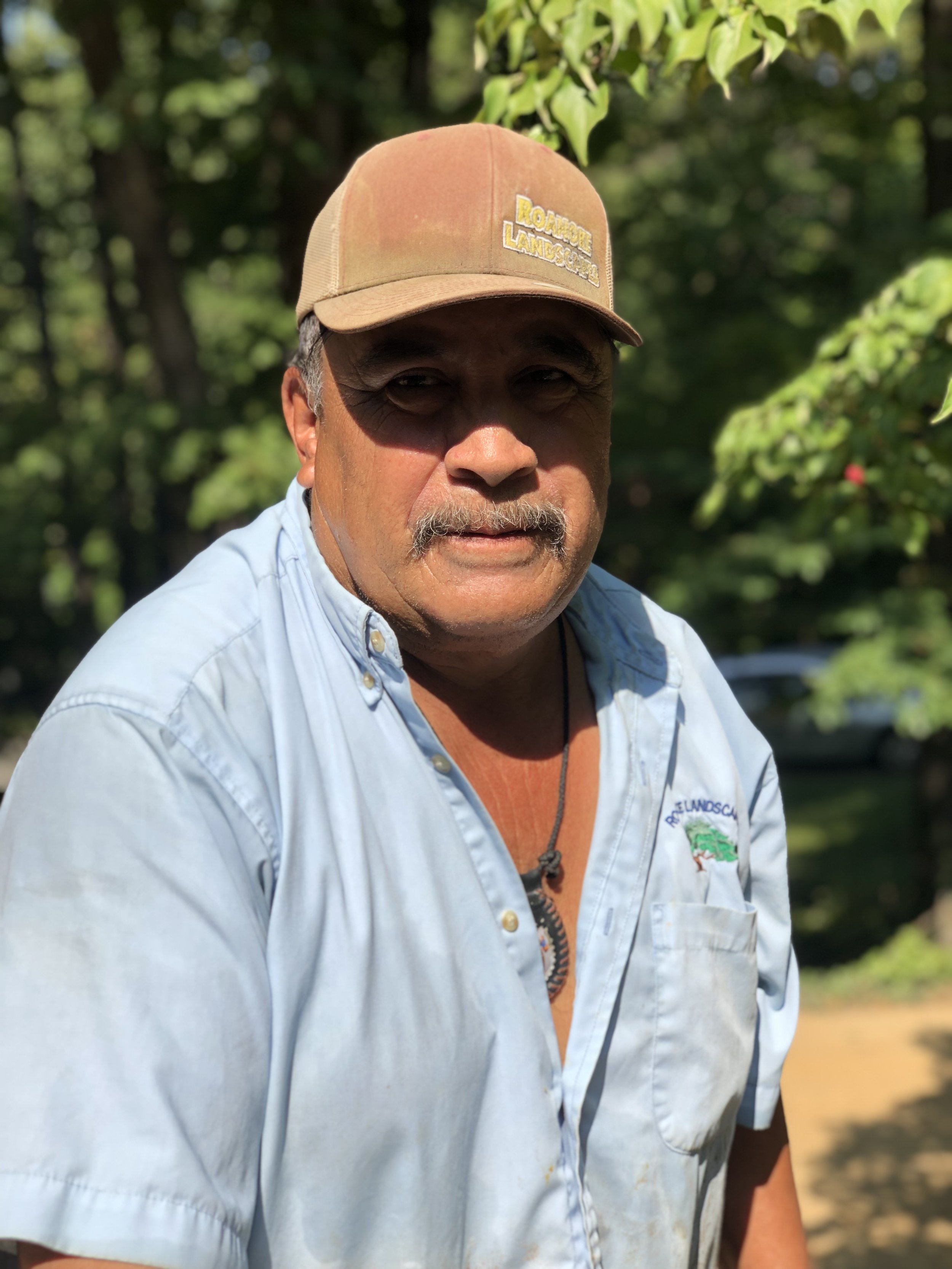Building a Natural Stone Retaining Wall
Get ready to get dirty! The first day, and depending upon the length of the wall, two or even three days, is spent digging the trench for the footing. As with any retaining wall, the footing is integral to maintaining structural stability. If you want a retaining wall for the ages the footing must be done correctly. This means digging deep enough, wide enough, and backfilling with the correct material. Any company that doesn’t plan to dig a footing should be avoided.
The footing must reach below the frost line, for Virginia, that’s roughly 12-14 inches deep. Beneath this point temperatures remain above 32 degrees year round, protecting the footer from heaving with freezing and fluctuating temperatures. This ensures your base is rigid and won’t move. If the footer isn’t beneath the frost line, your wall could fail. Companies providing you with quotes should be able to answer how deep they plan to dig their footer trench, and if they respond with anything less than the frost line, you should be leery and perhaps decide to look elsewhere.
-
Mortar
Limestone Footing
Virginia Mountain Stone
Wheelbarrow
Line Level & String
Chisel or rock splitter
Mallet
Maul or Sledgehammer
Tamper
Backhoe
The width of the trench needs to be half the height of the wall in feet. If your wall is 6 feet high, it must have a footing of at least 3 feet wide. This creates enough mass for the wall to be self-supporting. Again, providing structural support and allowing for space to engineer the wall with a battered profile (the wall leans into the soil behind it) an important aspect of a retaining wall.
Then is the matter of drainage. All retaining walls above 2 feet should have drainage. We install a perforated pipe that runs behind the wall to reroute water away from both your home and from behind the structure. Your wall is designed to provide enough mass to retain the soil behind it, without the perforated pipe, hydrostatic pressure increases and risks structural failure.
After we’ve dug your trench it’s time to begin creating the footer. We use riprap, or limestone to fill the trench to where the viewable wall begins, adding mortar across and between the stones to ensure stability in the footing. While companies might choose to use the same rock your viewable wall is created with, a choice that has no impact on the durability of the wall, it does have an impact on your wallet. If you aren’t going to see the stone, why would you choose to pay extra to have the rocks buried away? It’s a good idea to ask companies you’re fielding to do the work what stone they plan on using to backfill, especially if your estimate is far beyond the cost of other company quotes.
The Art of Construction
Once the footing is complete, the drainage installed, and the mortar applied our crews get to work on the process of the job that can only be described as artful! This is, perhaps, an understatement. What our crews accomplish, especially pertaining to a natural rock retaining wall, is a process of careful inspection of each rock, careful placement, and careful chiseling. As natural rock is, well, natural, each rock is different from the next. Unlike a segmental retaining wall where every block is identical to the next, making laying and building a much less time consuming process (you can read all about the construction here), natural rocks come in all shapes and sizes. You have to have creativity and imagination along with engineering and design to successfully build a natural stone wall.
Oscar and Juan are our best natural rock masons, they make the process appear quick and easy, when in reality it is anything but. Many of the rocks don’t have clean “faces,” or a portion of the rock that is flat and smooth to face outward. This means Oscar and Juan must create something beautiful and usable for a very particular place in the wall out of a rock that has nowhere else to go. We use chisels to achieve this, carefully taking a little here and a little there until the mason sees the stone become what they had already imagined and known they needed. It’s truly a remarkable thing to watch, and understanding the work that goes into the job makes the wall even more special to have on your property.
As I walked the office asking questions in preparation of writing this article, I heard many variations of the same sentiment. Sal’s analogy is that building a rock wall is much like making a cake from scratch. While certain aspects have to happen, others are up for the interpretation of the mason doing the work. While Randy might design and oversee the job, the aesthetic decisions concerning which rock needs chiseling and where that rock will go is in the hands of Juan and Oscar.
Oscar, Juan, & Enrique too!
Meet the team you’d likely see if Roanoke Landscapes builds your wall. First, Oscar & Juan, a father and son team that have the most expertise with natural stone retaining walls. Juan’s been in the businesses and with Roanoke Landscapes for 19 years, while Oscar, Juan’s son, for 12. We’re incredibly grateful to have them both. While other staff members are more than capable of creating this kind of property addition, we always try to have Oscar and Juan as the primary crew completing the jobs. Typically, they have the help of one additional crew member and most recently that has been Enrique (pictured on the right).
When asked about the craftsmanship that goes into this kind of work Juan replied “it’s good work. It takes creative vision to accomplish a project like this.” While Oscar remarked on the patience this type of work requires, “each rock has to be seen for where it will fit best in the wall. Where it will look best. If it doesn’t have a face that stands out, you have to make it. It takes a gentle but firm hand to craft this.”
Pricing the Project, Deciding Between Segmental and Natural Stone, & How Long Your Wall Will Stand
If your project is a parapet wall (free standing) you’re looking to pay roughly $50 per square foot. If your project is a retaining wall it’ll more likely be around $35 per square foot. This is conditional based upon the height of your wall, as well. The process of building a natural stone rock wall eliminates the ease of stacking that is typical with a segmental wall. Anything above 5 feet high, will require scaffolding so the crews are able to access and aesthetically craft each placement of stone. The segmental wall on the other hand doesn’t require the level of craftsmanship to stack each identical block, so crews are able to access and build from the top of each course.
Whether or not you decide on segmental or natural stone is completely up to you and your family. There are no structural limitations or hindrances that a natural rock wall presents that a segmental wall overcomes. Both types of walls are comparable in regards to strength and durability if properly constructed, so your decision comes down to aesthetics. For example, the property we’re working on while I write this article, already had natural stone rock walls in the back and side yard. A segmental block wall, in this instance, might not have been the best choice aesthetically. Thankfully, our staff is thoughtful, and takes all that your property has into consideration. If your home is more modern in its design, a segmental block wall will most likely heighten the exterior design. If your home is a cottage or farmhouse, a more natural look may blend more seamlessly into the landscape.
As mentioned above, strength and durability between your options are comparable. Both walls, when engineered and crafted correctly, promise the longevity you are looking for, and should expect.
If you’d like to get a quote from Roanoke Landscapes to add a natural stone retaining wall to your landscape, don’t hesitate to reach out! We’d love for you to see this process first hand, and to have a work of art installed on your property. Interested in following along in real time? Check out our social media pages:










